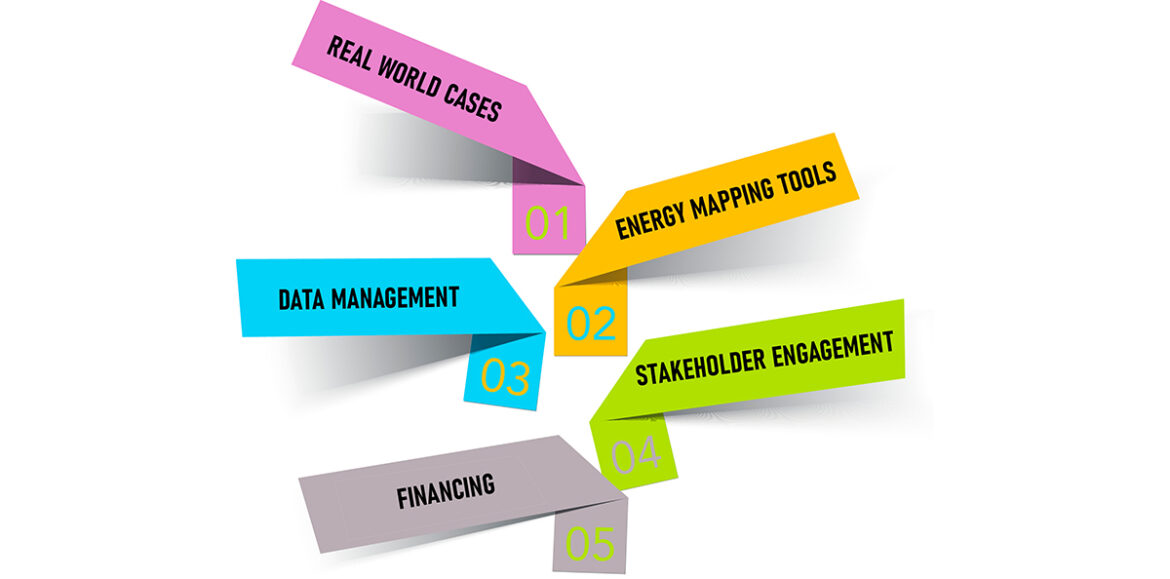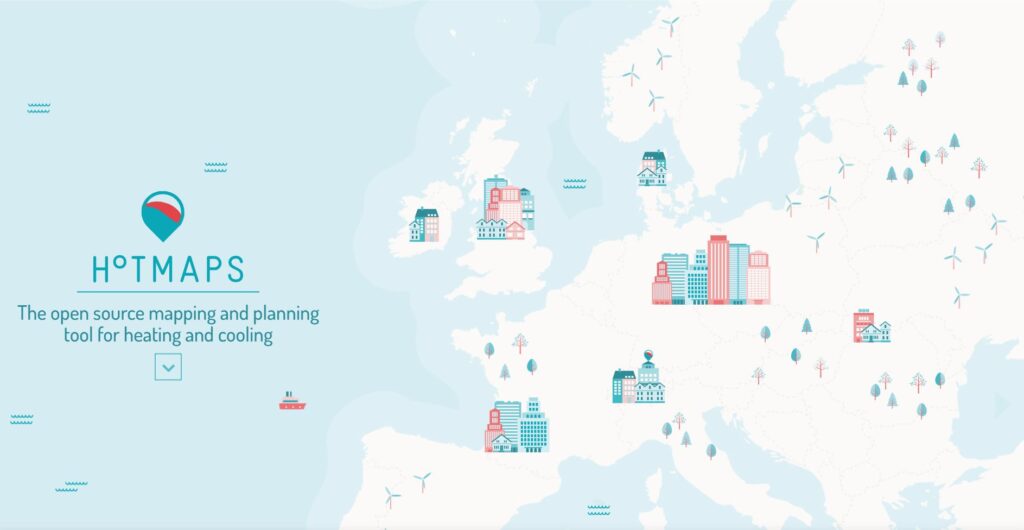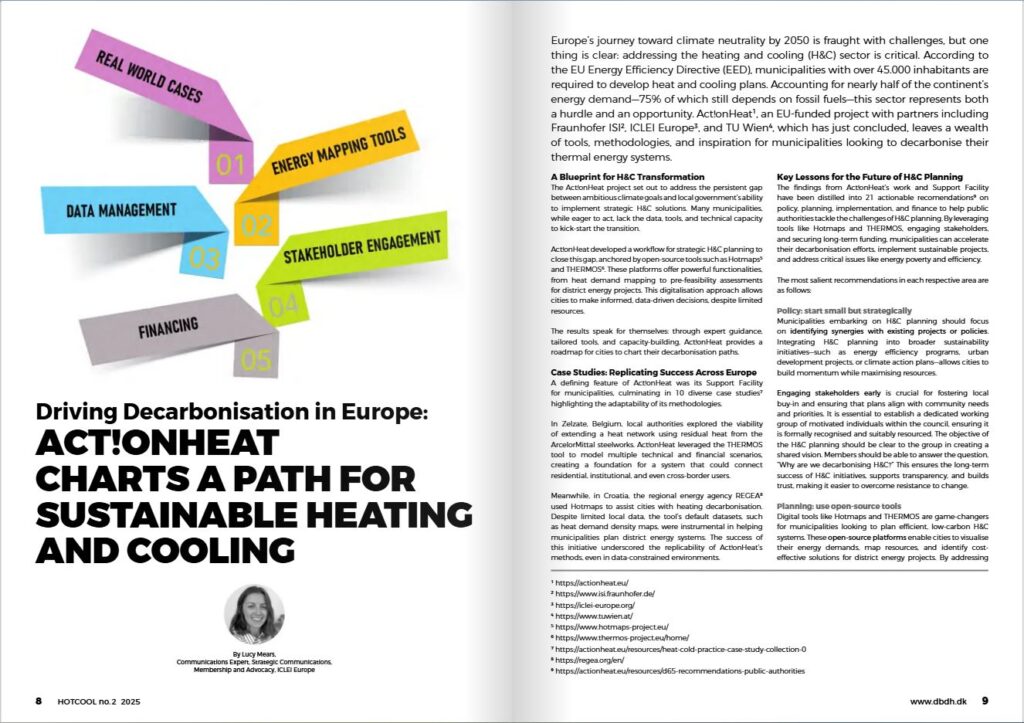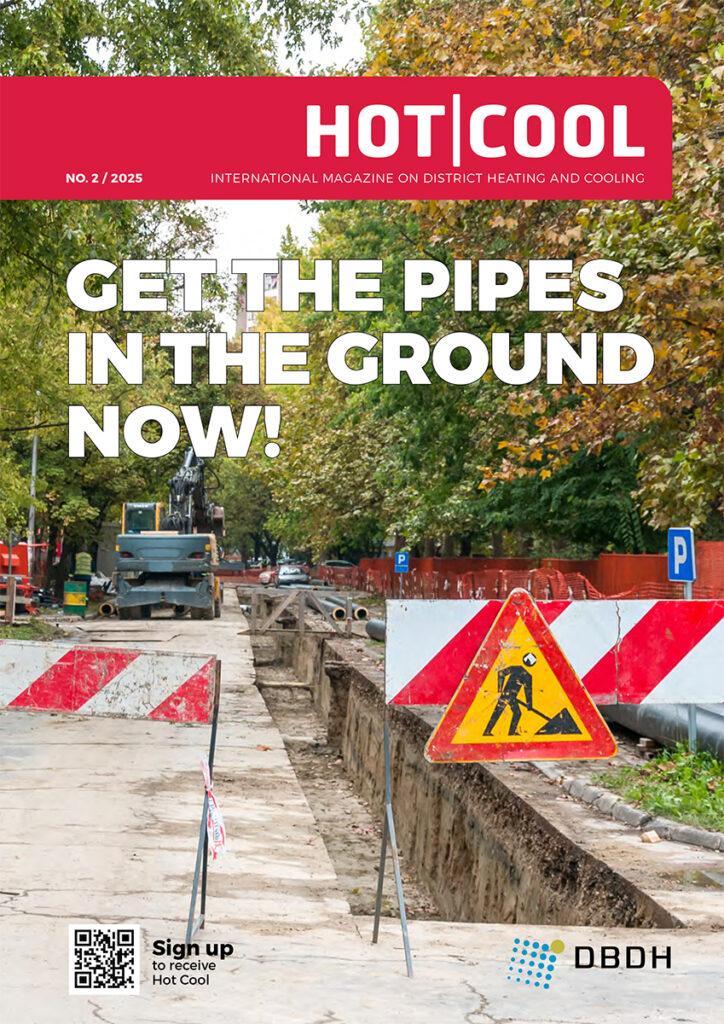Europe’s journey toward climate neutrality by 2050 is fraught with challenges, but one thing is clear: addressing the heating and cooling (H&C) sector is critical. According to the EU Energy Efficiency Directive (EED), municipalities with over 45.000 inhabitants are required to develop heat and cooling plans. Accounting for nearly half of the continent’s energy demand -75 % of which still depends on fossil fuels—this sector represents both a hurdle and an opportunity. Act!onHeat1, an EU-funded project with partners including Fraunhofer ISI2, ICLEI Europe3, and TU Wien4, which has just concluded, leaves a wealth of tools, methodologies, and inspiration for municipalities looking to decarbonise their thermal energy systems.
By Lucy Mears, Junior Expert, Events and Project Communications, ICLEI European Secretariat
Published in Hot Cool, edition no. 2/2025 | ISSN 0904 9681 |
A Blueprint for H&C Transformation
The Act!onHeat project set out to address the persistent gap between ambitious climate goals and local government’s ability to implement strategic H&C solutions. Many municipalities, while eager to act, lack the data, tools, and technical capacity to kick-start the transition.
Act!onHeat developed a workflow for strategic H&C planning to close this gap, anchored by open-source tools such as Hotmaps5 and THERMOS6. These platforms offer powerful functionalities, from heat demand mapping to pre-feasibility assessments for district energy projects. This digitalisation approach allows cities to make informed, data-driven decisions, despite limited resources.
The results speak for themselves: through expert guidance, tailored tools, and capacity-building, Act!onHeat provides a roadmap for cities to chart their decarbonisation paths.
Case Studies: Replicating Success Across Europe
A defining feature of Act!onHeat was its Support Facility for municipalities, culminating in 10 diverse case studies7 highlighting the adaptability of its methodologies.
In Zelzate, Belgium, local authorities explored the viability of extending a heat network using residual heat from the ArcelorMittal steelworks. Act!onHeat leveraged the THERMOS tool to model multiple technical and financial scenarios, creating a foundation for a system that could connect residential, institutional, and even cross-border users.
Meanwhile, in Croatia, the regional energy agency REGEA8 used Hotmaps to assist cities with heating decarbonisation. Despite limited local data, the tool’s default datasets, such as heat demand density maps, were instrumental in helping municipalities plan district energy systems. The success of this initiative underscored the replicability of Act!onHeat’s methods, even in data-constrained environments.
Key Lessons for the Future of H&C Planning
The findings from Act!onHeat’s work and Support Facility have been distilled into 21 actionable recomendations9 on policy, planning, implementation, and finance to help public authorities tackle the challenges of H&C planning. By leveraging tools like Hotmaps and THERMOS, engaging stakeholders, and securing long-term funding, municipalities can accelerate their decarbonisation efforts, implement sustainable projects, and address critical issues like energy poverty and efficiency.
The most salient recommendations in each respective area are as follows:
Policy: start small but strategically
Municipalities embarking on H&C planning should focus on identifying synergies with existing projects or policies. Integrating H&C planning into broader sustainability initiatives—such as energy efficiency programmes, urban development projects, or climate action plans—allows cities to build momentum while maximising resources.
Engaging stakeholders early is crucial for fostering local buy-in and ensuring that plans align with community needs and priorities. It is essential to establish a dedicated working group of motivated individuals within the council, ensuring it is formally recognised and suitably resourced. The objective of the H&C planning should be clear to the group in creating a shared vision. Members should be able to answer the question, “Why are we decarbonising H&C?” This ensures the long-term success of H&C initiatives, supports transparency, and builds trust, making it easier to overcome resistance to change.
Planning: use open-source tools
Digital tools like Hotmaps and THERMOS are game-changers for municipalities looking to plan efficient, low-carbon H&C systems. These open-source platforms enable cities to visualise their energy demands, map resources, and identify cost-effective solutions for district energy projects. By addressing data gaps and simplifying complex processes, the tools make strategic planning more accessible—even for cities with limited budgets or technical expertise.
For example, Hotmaps is a GIS-based online software that supports authorities and energy planners in setting up a strategic H&C plan for their region. At the same time, THERMOS is a free, web-based energy planning software designed to optimise local district energy network planning processes and sustainable energy master planning to facilitate the deployment of new low-carbon H&C systems and a fast upgrade, refurbishment, and expansion of existing systems.
Together, these tools streamline decision-making, reduce planning costs, and accelerate project timelines. By integrating these platforms into their workflows, cities can make data-driven decisions that result in more sustainable and effective H&C systems.
Finance: innovate in financing
Successfully implementing H&C projects often hinges on finding the right financing model. Public-private partnerships (PPPs) are a particularly effective way to attract investment, combining public-sector support with private-sector expertise and funding. For example, green bonds and EU funding mechanisms can help lower the financial risks associated with large-scale infrastructure projects like district heating networks.
Municipalities should also explore innovative funding approaches tailored to their specific contexts. Blending local, national, and EU-level resources allows cities to secure the capital to launch ambitious decarbonisation projects. Additionally, ensuring long-term, sustainable funding is crucial to covering the full lifecycle costs of H&C systems, from initial construction to ongoing maintenance and future expansion.
Implementation: prioritise digitalisation
Digitalisation is a cornerstone of modern H&C planning, enabling cities to leverage data and technology to optimise energy systems efficiently. Digital tools streamline technical processes and create clear visualisations that help decision-makers and stakeholders understand the benefits of proposed projects. This clarity is crucial for securing political support and public approval.
Moreover, digitalisation accelerates the planning and implementation of H&C projects by automating complex calculations and analyses. For instance, energy mapping tools like Hotmaps and THERMOS allow cities to test multiple scenarios quickly, helping them identify the most cost-effective and sustainable solutions. By prioritising digital solutions, municipalities can overcome resource limitations, improve collaboration, and ensure that their H&C systems are ready to meet future energy demands.
A Roadmap for Replication
Act!onHeat’s Local Replication Roadmap10 is a cornerstone of the project’s legacy, designed to help municipalities overcome barriers to H&C planning. This roadmap provides a step-by-step guide to adopting sustainable practices, drawing on workflows, energy mapping tools, and actionable case studies to ensure adaptability to local needs.
Key Components of the Roadmap
The roadmap begins by outlining a comprehensive H&C planning and financing process. Municipalities are guided through the initial stages, such as assessing local energy needs and potential, setting strategic objectives, and engaging stakeholders. A structured workflow ensures cities can tailor their planning efforts to align with specific circumstances, making even complex projects manageable.
A central feature of the roadmap is its focus on tools for strategic planning, specifically Hotmaps and THERMOS. Hotmaps provides heat demand density maps, renewable energy assessments, and cost comparisons between heating options. Meanwhile, THERMOS simplifies district heating planning by offering rapid scenario modeling, allowing municipalities to make informed decisions about network expansions or alternative solutions.
Practical Case Studies and Training Materials
The roadmap is enriched by real-world case studies and examples, demonstrating how its methodologies can be applied in diverse settings. From extending district heating networks to integrating renewable energy sources, these examples illustrate the flexibility of Act!onHeat’s approach.
In addition, the roadmap provides training materials to build local capacity. These resources feature detailed tutorials on the energy mapping tools, along with guidance on data management, stakeholder engagement, and project financing. This ensures that municipalities develop actionable plans and gain the expertise needed to implement and sustain them effectively.
By integrating insights from case studies and leveraging open-source tools, the roadmap empowers cities to visualise energy demands, prioritise projects, and secure funding for decarbonisation initiatives. Whether municipalities are starting their H&C journey or refining established systems, the roadmap provides a clear path forward, ensuring that Act!onHeat’s impact extends well beyond its pilot projects.
To learn more, explore the roadmap and associated resources on the Act!onHeat website.
A Final Call to Action: The Role of Digitalisation and Collaboration
The importance of digitalisation was a central theme at Act!onHeat’s final conference, Make Your Digital Sprint in Heating and Cooling11, held in Brussels on 13 November 2024. Experts, policymakers, and energy practitioners came together to discuss the future of H&C planning in Europe, where they emphasised the potential of digitalisation to drive efficiency and faster implementation.
Energy mapping tools were showcased as essential for enabling cities to optimise energy use. As Morten Duedahl from the Danish Board of District Heating remarked, “digitalisation is an opportunity to plan properly. We must use the data we have and act now.”
Collaboration also emerged as a key theme. Andrea Voigt from Danfoss underscored the importance of public-private partnerships, noting, “There’s a real need to support these collaborations to fully leverage synergies.”
Addressing data gaps through open access and engaging stakeholders more effectively were other critical takeaways for ensuring sustainable outcomes. For example, Vesna Derzek from the City Utility Velenje in Slovenia shared innovative approaches to stakeholder engagement. Her team identified six distinct community groups in Velenje and created detailed “personas” representing factors such as accommodation type, occupation, age, education, social networks, financial position, and attitudes toward climate issues. By tailoring messages to resonate with each group, this strategy fostered trust and inclusivity in the energy transition.
Finally, Leszek Drogosz, Director of Infrastructure for the City of Warsaw, highlighted the broader implications of AI-based technologies for urban energy systems:
“Digital transformation is key to achieving faster decarbonisation and energy efficiency. By integrating AI-based technologies, passive building models, and innovative heating solutions, cities like Warsaw are setting the standard for reducing energy consumption through sustainable urban energy systems.”
The conference highlighted the need for innovation and action. From addressing data gaps to creating clear visualisations for decision-makers, digital tools like energy mapping tools are already reshaping what’s possible for cities striving for sustainability.
Speaker presentations are available here.
The Path Forward
As Europe races to meet its 2050 climate neutrality targets, the lessons of Act!onHeat are clear: bold action at the local level is indispensable. Municipalities armed with the right tools and strategies can drive the transition to sustainable H&C systems—one project at a time.
For cities ready to take the next step, the resources developed by Act!onHeat, including case studies, planning tools, and the Local Replication Roadmap, provide an invaluable starting point.
Visit the Act!onHeat website to explore these materials and join the growing community of municipalities committed to transforming Europe’s energy future.
Footnotes:
1 https://actionheat.eu/
2 https://www.isi.fraunhofer.de/
3 https://iclei-europe.org/
4 https://www.tuwien.at/
5 https://www.hotmaps-project.eu/
6 https://www.thermos-project.eu/home/
7 https://actionheat.eu/resources/heat-cold-practice-case-study-collection-0
8 https://regea.org/en/
9 https://actionheat.eu/resources/d65-recommendations-public-authorities
10 https://actionheat.eu/local-replication-roadmap
11 https://actionheat.eu/resources/d65-recommendations-public-authorities
For further information, please contact: lucy.mears@iclei.org
“Driving Decarbonisation in Europe: Act!onHeat Charts a Path for Sustainable Heating and Cooling” was published in Hot Cool, edition no. 2/2025. You can download the article here:
meet the author
Lucy Mears
Did you find this article useful?
Subscribe to the HOT|COOL newsletters for free and get insightful articles on a variety of topics delivered to your inbox twice a month!



